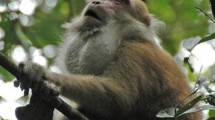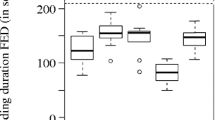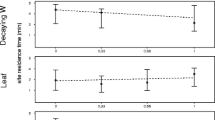Summary
The impact of aggresive competition on food intake at all the resources used is analysed for every member of a group of brown capuchin monkeys (Cebus apella) in the Manu National Park, Peru, where they live in groups of 8–14 animals. An individual's food intake at a given tree was affected independently both by its domirance rank (Fig. 1) and by how much aggression it received (Table 5). Food intake was not strongly affected by body size when dominance rank was held constant by partial correlation. At food sources where high rates of fighting occurred, an individual's food intake depended more on its domirance status than on the rate of aggression it received (Fig. 2). However, food intake at resources where rates of fighting were low depended mostly on the rate of aggression received. When aggression over food was absent, the food intakes of dominants and subordinates were equal. Dominants had significantly greater total energy intake (20.5% more) than did subordinates, even though more than one third of their diet came from food sources where little or no fighting occurred (Fig. 3). Energy intake was also significantly greater for individuals that received little aggression. The only adult that emigrated from the main study group was the individua with the lowest energy intake. Competition for food within groups was more than ten times as intense as competition between brown capuchin groups.
Similar content being viewed by others
References
Alexancer RD (1974) The evolution of social behavior. Annu Rev Ecol Syst 5:325–383
Altmann J (1974) Observational study of behavior. Sampling methods. Behaviour 49:227–267
Altman J (1980) Baboon mothers and infants. Harvard University Press, Cambridge, Mass
Appleby MC (1983) The probability of linearity in hierarchies. Anim Behav 31:600–608
Arnold SJ (1983) Sexual selection: the interface of theory and empricism. In: Bateson PPG (ed) Mate Choice. Cambridge University Press, Cambridge, pp 67–107
Baker MC (1978) Flocking and feeding and the Great Tit Parus major — an important consideration. Am Nat 112:779–781
Caraco T (1979) Time budgeting and group size: a test of theory. Ecology 60:618–627
Caraco T, Wolf TT (1975) Ecological determinants of group sizes of foraging lions. Am Nat 109:343–352
Carpenter CR (1942) Societies of monkeys and apes. In: Redfield R (ed) Levels of integration in biological and social systems. Jacques Cattell Press, Lancaster, pp 177–204
Cohen J (1971) Casual groups of monkeys and men: stochastic models of elemental social systems. Harvard University Press, Cambridge, Mass
Clutton-Brock TH, Harvey PH (1976) Evolutionary rules and prinate societies. In: Bateson PPG, Hinde RA (eds) Growing points in ethology. Cambridge University Press, Cambridge, pp 195–237
Clutton-Brock TH, Harvey PH (1977) Species differences in feeding and ranging behaviour in primates. In: Clutton-Brock TH (ed) Primate Ecology: Studies of feeding and ranging behaviour in lemurs, monkeys, and apes. Academic Press, New York, pp 557–584
Crook JH (1965) The adaptive significance of avian social organizations. Symp Zool Soc London 14:181–218
Crook JH, Gartlan JS (1966) On the evolution of primate societies. Nature 210:1200–1203
Denham WW (1971) Energy relations and some basic properties of primate social organization. Am Anthro 73:77–95
Dittus WPJ (1977) The social regulation of population density and age-sex distribution in the toque monkey. Behaviour 63:281–322
Greenwood PJ (1980) Mating systems, philopatry, and dispersal in birds and mammals. Anim Behav 28:1140–1162
Hladik CM (1977) Field methods for processing food samples. In: Clutton-Brock TH (ed) Primate Ecology: Studes of feeding and ranging behaviour in lemurs, monkeys, and apes. Academic Press, New York, pp 595–603
Holdrioge LR (1947) Determination of world plant formations from simple climatic data. Science 105:367–368
Hull CH, Nie NH (1981) SPSS. Update 7–9. McGraw-Hill, New York
Izawa K (1980) Social behavior of the wild black-capped capuchin (Cebus apella). Primates 21:443–467
Janson CH (1984) Female choice and mating system of the brown capuchin monkey Cebus apella (Primates: Cebidae). Z Tierpsychol 65:177–200
Janson CH (1985) Ecological and social consequences of food competition in brown capuchin monkeys. PhD Thesis, University of Washington, Seattle
Janson CH, Wright PC (1980) Parent-offspring relations in the brown capuchin (Cebus apella). Am J Phys Anthropol 52:241
Janson CH, Terborgh JW, Emmons LH (1981) Non-flying mammals as pollinating agents in the Amazonian forest. Biotropica 13:1–6
Kurland JA (1977) Kin selection in the Japanese monkey. Contributions to Primatology No. 12. Karger, Basel
Leighton M, Leighton DR (1982) The relationship of size of feeding aggregate to size of food patch: Howler monkeys (Alouatta palliata) feeding in Trichilia cipo fruit trees on Barro Colorado Island. Biotropica 14:81–90
Maghsoodoo S (1975) Estimates of the quantiles of Kendall's partial rank correlation coefficient. J Stat Comp Simul 4:155–64
Maslow AH, Flauzbaum S (1936) An experimental determination of the behavior syndrome of dominance. J Genet Psychol 48:278–309
Nicolosi RJ, Hunt RD (1979) Dietary allowances for nutrients in non-human primates. In: Hayes KC (ed) Primates in Nutritional Research. Academic Press, New York, pp 11–37
Oppenheimer JR (1969) Changes in forehead patterns and group composition of the white-faced capuchin (Cebus capucinus). In: proceedings of the 2nd international congress of primatology, Atlanta, vol 1. Karger, Basel, pp 36–42
Packer C (1979) Male dominance and reproductive activity in Papio anubis. Anim Behav 27:37–45
Plotnick R (1968) Effects of competition on the aggressive behavior of squirrel and Cebus monkeys. Behaviour 32:315–332
Post DG, Hausfater G, McCuskey SA (1980) Feeding behavior of yellow baboons (Papio cynoceohalus): relationship to age, gender and dominance rank. Folia Primatol 34:170–195
Robinson JG (1981) Spatial structure in foraging groups of wedge-capped capuchin monkeys Cebus nigrivittatus. Anim Behav 29:1036–1056
Samonds KW, Hegsted DM (1973) Protein requirements of young Cebus monkeys (Cebus albifrons and apella). Am J Clin Nutr 26:30–40
Schaik CP van, Noordwijk MA van, Boer RJ de, Tonkelaar I den (1983) The effect of group size on time budgets and social behaviour in wild long-tailed macaques (Macaca fascicularis). Behav Ecol Sociobiol 13:173–181
Sen PK (1968) Estimates of the regression coefficient based on Kendall's tau. J Am Stat Assoc 63:1379–1389
Seyfarth RM (1977) Models of social grooming among adult female monkeys. J Theor Biol 65:671–698
Siegel S (1956) Non-parametric Statistics for the Behavioral Sciences. McGraw-Hill, New York
Sokal RR, Rohlf FJ (1981) Biometry. 2nd edn. Freeman, San Francisco
Southwick CH (1967) An experimental study of intragroup agoniste behavior in Rhesus Monkeys (Macaca mulatta). Behaviour 28:182–209
Stammbach E, Kummer H (1982) Individual contributions to a dyadic interaction: an analysis of baboon grooming. Anim Behav 30:964–972
Terborgh JW (1983) Five new world primates: A study in comparative ecology. Behavioral Ecology Monographs no. 1. Princeton University Press, Princeton
Terborgh JW, Janson CH (1983) The ecology of primates in southeastern Peru. Nat Geogr Soc Res Rep 15:655–662
Terborgh JW, Fitzpatrick FW, Emmons L (1984) Annotated checklist of bird and mammal species of Cocha Cashu Biological Station, Manu National Park, Peru. Fieldiana, Zoology, New Series, No. 21. Field Museum of Natural History, Chicago
Vehrencamp SL (1983) A model for the evolution of despotic versus egalitarian societies. Anim Behav 31:667–682
Waser PM (1976) Cercocebus albigena—site attachment, avoidance, and intergroup spacing. Am Nat 110:911–935
White DW, Stiles EW (1985) The use of refractometry to estimate nutritional rewards in vertebrate-dispersed fruits. Ecology 66:303–307
Whitten PL (1983) Diet and dominance among female vervet monkeys (Cercopithecus aethiops). Am J Primatol 5:139–159
Wittenberger JF (1980) Animal social behavior. Duxbury Press, Boston
Wrangham RW (1980) An ecological model of female-bonded primate groups. Behaviour 75:262–299
Author information
Authors and Affiliations
Rights and permissions
About this article
Cite this article
Janson, C. Aggresive competition and individual food consumption in wild brown capuchin monkeys (Cebus apella). Behav Ecol Sociobiol 18, 125–138 (1985). https://doi.org/10.1007/BF00299041
Received:
Accepted:
Issue Date:
DOI: https://doi.org/10.1007/BF00299041




